Series Retrospective: Capture the memories of the ever-evolving world of Pokemon starting with Red and Blue and ending with a special look at the upcoming Diamond and Pearl versions.
Pimpin' the Pokemerchandise
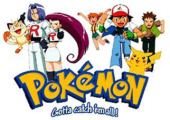
Days before Pokemon Red and Blue debuted in North America, the anime premiered in the region through syndication. This television show followed Ash Ketchum and a Pikachu, his first Pokemon, as Ash attempted to become the world's greatest trainer. Traveling along with the duo were Brock and Misty and their Pokemon. Gary Oak, the Professor's grandson, represented the rival from the game. In Japan, his name was Shigeru named after Nintendo's renowned Shigeru Miyamoto, while Ash was named Satoshi after Satoshi Tajiri in the anime. These names were changed in the U.S. along with the infamous seizure-causing Electric Soldier Porygon episode. A simulated explosion in Japanese show #38 caused more than 600 viewers to become sick, so the episode was banned and the series' visuals effects were toned down.
The cartoon loosely followed the premise of the two Game Boy games, only it contained a far more detailed script. Thus, audiences could further explore the colorful world of Pokemon alongside these likeable characters with poorly dubbed English voices. Despite the dialogue being spoken in English and mouths drawn to follow the Japanese words, people still tuned in to discover new monsters, watch exciting battles and laugh at Team Rocket, the haphazard evil crime syndicate.
The Pokemon anime improved over the months as it became more popular in the United States. First, the mouths of characters began moving in time with the English dialogue. Second, episodes transitioned from scattered syndication to a single network by airing on the Kids WB! in February 1999. The Johto adventures and the first set of the Advanced Generation episodes also appeared on the channel until it ceased to exist when it merged with UPN to form the CW Network. Pokemon fell into the hands of Cartoon Network, which continued the anime in 2006.
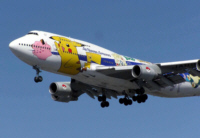
As Pokemon became a household name, being pronounced Po-kay-mon, Po-kee-mon and Po-kuh-mon, the franchise moved on to other mediums and merchandise. There have been eight movies so far (half in theatres, half on DVD), a popular trading card game (introduced by makers of Magic: The Gathering), toys (both the Hasbro kind and the Burger King kind), comics, clothing, cereals and snacks. The extent of the license was sky high both figuratively and literally with Pokemon-branded jets.
The first Pokemon spin-offs
Pikachu appeared as a playable character in Super Smash Bros. in April 1999. As a small, electricity-charged fighter, he was ideal for quick aerial dash attacks on slower characters and cheap lightning attacks on enemies at a distance. Although Pikachu was the only Pokemon immediately available, Jigglypuff could also be unlocked as a playable fighter by completing the single-player portion of SSB. This unsuspectingly cute Pokemon could be quite annoying to other players because it put everyone to sleep if they were in a close enough range.
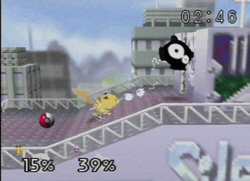
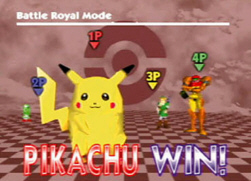
More than a dozen other Pokemon showed up as non-playable characters in SSB. They all came in the form of randomly dropped Poke Balls, one of many special items that could be used throughout the fighting frenzy. A player could pick up and throw a ball to release a random Pokemon and receive help from its attack on everyone else. Characters included the flame-throwing Charizard, the Smog-dispensing Koffing and the boulder-crushing Onix. Additional monsters like Chansey, Electrode and Venusar were released as part of a trap door in the Pokemon-themed stage Saffron City.
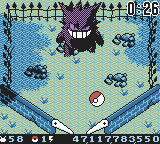
The summer of that same year came Pokemon Pinball. Released for Game Boy Color, the game followed the two-word title in combining Pokemon characters with pinball. Instead of a silver ball, however, there was a Poke Ball that could be used to capture and evolve monsters in order to complete the Pokedex. The remainder of the game kept to the familiar principles of pinball like racking up a high score. One unfamiliar extra found on the game (rather than in the game) was the built-in rumble cartridge.
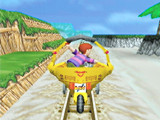
Pokemon Snap one-upped the colorized Pokemon Pinball game one month later by giving trainers a chance to see their pocket monsters in 3D on N64. The problem was that seeing the Pokemon was the only thing anyone could do. Rather than create a full 3D adventure for the more powerful console, Nintendo simplified the objective to taking photographs of the creatures instead. The premise, considered innovative by some, suffered from a lack of levels and lack of Pokemon (less than half of the 151).
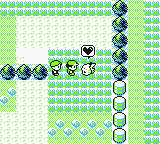
The first Pokemon generation ended with Pokemon Yellow: Special Pikachu Edition, released in October 1999 in America. The Game Boy game took the anime into account by pairing players up with a Pikachu and placing the yellow mouse-like monster on the box art. While the character wasn't Ash Ketchum from the cartoon, the Pikachu did follow the hero around because it didn't like staying in a Poke Ball, as in the first episode of the anime. Another significant difference between this game and the Red and Blue versions is that it included the show's evil crime syndicate Team Rocket.
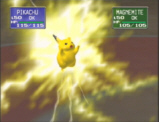
Monster-on-monster combat finally came to the N64 with the March 2000 release of Pokemon Stadium in North America. In Japan, it was called Pokemon Stadium 2 due to Nintendo of Japan releasing Pocket Monsters Stadium in 1998 and never letting it leave their shores. The two-year wait for a U.S. version was worth it because the original only featured a few dozen Pokemon, less than the seriously lacking Pokemon Snap. The new game included all 151 monsters and also included a Transfer Pak. This device plugged into the console's underneath slot on the controller and allowed players to plug a Game Boy cartridge into the Transfer Pak. This enabled captured Pokemon to be moved from the monochrome Game Boy to the 64-bit N64. In addition to dramatic battles and fun mini-games involving four players, Pokemon Stadium served as a way to play the handheld adventure on the big screen.
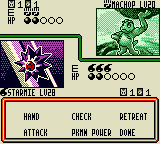
Battling of a different form occurred the next month when Wizards of the Coast came out with Pokemon Trading Card Game for Game Boy Color in April 2000. Players had to build a deck out of 200-plus cards and compete against other card masters in an adventure structure similar to the original Pokemon games. As an incentive to those hooked on the actual trading card game, this digital edition included a limited edition trading card inside the box.
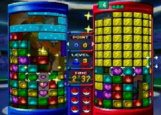
Nintendo took SNES' Tetris Attack, Pokified it and put out Pokemon Puzzle League for N64 in September 2000. Not only was the game full of Pokemon, but it also included Ash Ketchum, making it the first game to use the anime hero. The only big gameplay difference between Puzzle League and Tetris Attack was the 3D cylinders in addition to the flat 2D playing fields.